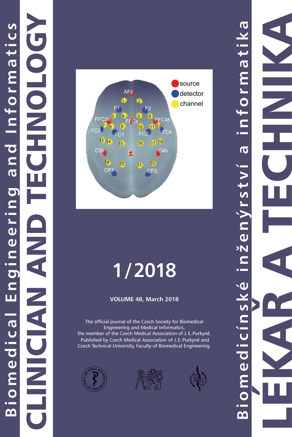MEDIAN METHOD FOR DETERMINING CORTICAL BRAIN ACTIVITY IN A NEAR INFRARED SPECTROSCOPY IMAGE
Keywords:
near infrared spectroscopy, neuroimaging, Parkinson's disease, neurophotonics, brain mapping, neuromodulationAbstract
Near-InfraRed-Spectroscopy (NIRS) is a neuroimaging method of brain cortical activity using low-energy optical radiation to detect local changes in (de)oxyhaemoglobin concentration. A methodology consisting of a raw signal pre-processing phase, followed by statistical analysis based on a general linear model, is currently being used to determine signal activity. The aim of this research is to define the median modification of the standard method usually used for the estimation of cortical activity from the NIRS signal and to verify its applicability in measuring motor tasks for patients with Parkinson's disease. Individual examinations were conducted in 10 cycles, during which finger tapping, and rest phases were alternating. Changes in oxyhaemoglobin concentration were calculated from the native NIRS signal using the modified Lambert-Beer equation. The signals were filtered in the 0.015–0.3 Hz band and fitted by the physiological response function of the brain tissue for each finger tapping cycle separately. The median value from the 10 cycles was then computed. Activity values obtained in individual subjects have been used in Brain Mapping visualizations. These describe motor task patterns during the ON and OFF deep brain stimulation of the subthalamic nucleus in Parkinson's disease, which demonstrates activation in accordance with the current state of knowledge in functional imaging.Downloads
Published
Issue
Section
License
Copyright (c) 2018 Ondřej Klempíř

This work is licensed under a Creative Commons Attribution 4.0 International License.
Authors who publish with this journal agree to the following terms:
- Authors retain copyright and grant the journal right of the first publication with the work simultaneously licensed under a Creative Commons Attribution License (https://creativecommons.org/licenses/by/4.0/) that allows others to share the work with an acknowledgment of the work's authorship and initial publication in CTJ.
- Authors are able to enter into separate, additional contractual arrangements for the non-exclusive distribution of the journal’s published version of the work (e.g., post it to an institutional repository or publish it in a book), with an acknowledgment of its initial publication in this journal.
- Authors are permitted and encouraged to post their work online (e.g., in institutional repositories or on their website or ResearchGate) prior to and during the submission process, as it can lead to productive exchanges.
CTJ requires that all of the content of the manuscript has been created by its respective authors or that permission to use a copyrighted material has been obtained by the authors before submitting the manuscript to CTJ. CTJ requires that authors have not used any copyrighted material illegally, as for example a picture from another journal or book, a photo, etc. It is the author’s responsibility to use only materials not violating the copyright law. When in doubt, CTJ may ask the authors to supply the pertinent permission or agreement about the use of a copyrighted material.
The opinions expressed in CTJ articles are those of authors and do not necessarily reflect the views of the publishers or the Czech Society for Biomedical Engineering and Medical Informatics.


